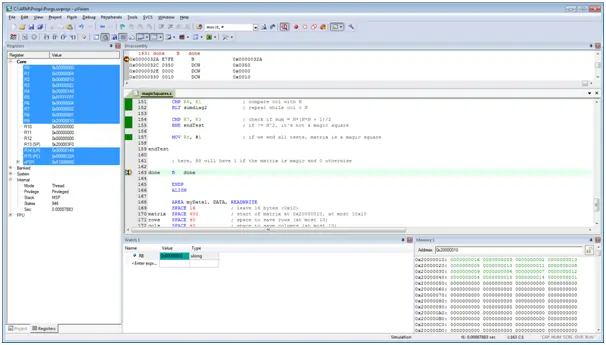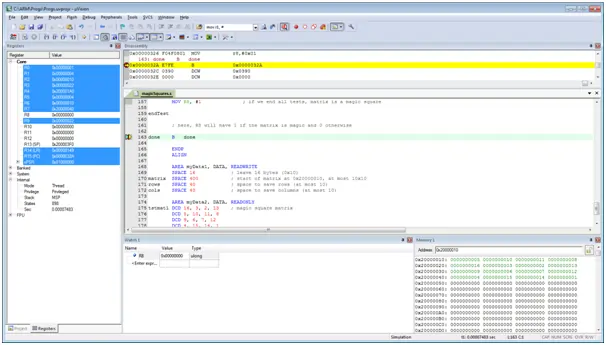Instructions
Objective
Write an ARM assignment to check if a magic square is valid in ARM assembly language using KEIL.
Requirements and Specifications
.webp)
Screenshots of output


Source Code
AREA magicSquares, CODE
EXPORT __main
ALIGN
ENTRY
__main PROC
; the code will initialize R1 and use a test matrix to run the code,
; if R1 is set somewhere else and a matrix is set at 0x20000010,
; then uncomment the following line
; B start
MOV R1, #4 ; matrix size N
; copy test matrix to matrix space at 0x20000010
LDR R2, =tstmat1 ; start address of test matrix 1
;LDR R2, =tstmat2 ; start address of test matrix 2
LDR R3, =0x20000010 ; start address of matrix
MOV R4, R1 ; number of rows
copyrows
MOV R5, R1 ; number of cols
copycols
LDR R0, [R2], #4 ; load value from test matrix
STR R0, [R3], #4 ; store value in matrix
SUBS R5, R5, #1 ; decrement remaining cols
BNE copycols ; repeat while not zero
SUBS R4, R4, #1 ; decrement remaining rows
BNE copyrows ; repeat while not zero
start
; fill rows variable
LDR R2, =0x20000010 ; load address of matrix
LDR R3, =rows ; point to start of rows array
LSL R4, R1, #2 ; size of a row = N*4
MOV R5, #0 ; start in position 0
loopr
STR R2, [R3, R5, LSL #2]; save address in rows
ADD R2, R2, R4 ; advance to next row
ADD R5, R5, #1 ; increment index
CMP R5, R1 ; compare index with N
BLT loopr ; repeat while i < N
; fill cols variable
LDR R2, =0x20000010 ; load address of matrix
LDR R3, =cols ; point to start of cols array
MOV R4, #0 ; start in position 0
loopc
STR R2, [R3, R4, LSL #2]; save address in cols
ADD R2, R2, #4 ; advance to next col
ADD R4, R4, #1 ; increment index
CMP R4, R1 ; compare index with N
BLT loopc ; repeat while i < N
; calculate sum number = N*(N^2 + 1)/2
MUL R2, R1, R1 ; N*N
ADD R3, R2, #1 ; N*N + 1
MUL R3, R3, R1 ; N*(N*N + 1)
LSR R3, R3, #1 ; N*(N*N + 1)/2
MOV R8, #0 ; assume it's not magic at start
; First we test the matrix elements
LDR R4, =rows ; load rows
MOV R5, #0 ; row index
loop1
LDR R6, [R4, R5, LSL #2] ; load row address
MOV R7, #0 ; col index
loop2
LDR R0, [R6, R7, LSL #2] ; load element from row
CMP R0, #1 ; check if >= 1
BLT endTest ; if < 1, it's not a magic square
CMP R0, R2 ; check if <= N^2
BGT endTest ; if > N^2, it's not a magic square
ADD R7, R7, #1 ; increment col index
CMP R7, R1 ; compare index with N
BLT loop2 ; repeat while col < N
ADD R5, R5, #1 ; increment row index
CMP R5, R1 ; compare index with N
BLT loop1 ; repeat while row < N
; We now test the row sums
LDR R4, =rows ; load rows
MOV R5, #0 ; row index
sumrows1
LDR R6, [R4, R5, LSL #2] ; load row address
MOV R7, #0 ; col index
MOV R9, #0 ; start sum in zero
sumcols1
LDR R0, [R6, R7, LSL #2] ; load element from row
ADD R9, R9, R0 ; add element to sum
ADD R7, R7, #1 ; increment col index
CMP R7, R1 ; compare index with N
BLT sumcols1 ; repeat while col < N
CMP R9, R3 ; check if sum = N*(N*N + 1)/2
BNE endTest ; if != N^2, it's not a magic square
ADD R5, R5, #1 ; increment row index
CMP R5, R1 ; compare index with N
BLT sumrows1 ; repeat while row < N
; We now test the column sums
LDR R4, =cols ; load cols
MOV R5, #0 ; col index
sumcols2
LDR R6, [R4, R5, LSL #2] ; load col address
MOV R7, #0 ; row index
MOV R9, #0 ; start sum in zero
sumrows2
MUL R0, R7, R1 ; row * num cols
LSL R0, R0, #2 ; address of element = row * num cols * 4
LDR R0, [R6, R0] ; load element from col
ADD R9, R9, R0 ; add element to sum
ADD R7, R7, #1 ; increment row index
CMP R7, R1 ; compare index with N
BLT sumrows2 ; repeat while row < N
CMP R9, R3 ; check if sum = N*(N*N + 1)/2
BNE endTest ; if != N^2, it's not a magic square
ADD R5, R5, #1 ; increment col index
CMP R5, R1 ; compare index with N
BLT sumcols2 ; repeat while col < N
; We now test the first diagonal sum
LDR R4, =rows ; load rows
MOV R5, #0 ; row index
MOV R6, #0 ; start sum in zero
sumdiag1
LDR R7, [R4, R5, LSL #2] ; load row address
LDR R0, [R7, R5, LSL #2] ; load element from row at index position (row,row)
ADD R6, R6, R0 ; add element to sum
ADD R5, R5, #1 ; increment row index
CMP R5, R1 ; compare index with N
BLT sumdiag1 ; repeat while row < N
CMP R6, R3 ; check if sum = N*(N*N + 1)/2
BNE endTest ; if != N^2, it's not a magic square
; Lastly, we test the second diagonal sum
LDR R4, =rows ; load rows
SUB R5, R1, #1 ; row index = N-1
MOV R6, #0 ; col index = 0
MOV R7, #0 ; start sum in zero
sumdiag2
LDR R9, [R4, R5, LSL #2] ; load row address
LDR R0, [R9, R6, LSL #2] ; load element from row at index position (row,col)
ADD R7, R7, R0 ; add element to sum
SUB R5, R5, #1 ; decrement row index
ADD R6, R6, #1 ; increment col index
CMP R6, R1 ; compare col with N
BLT sumdiag2 ; repeat while col < N
CMP R7, R3 ; check if sum = N*(N*N + 1)/2
BNE endTest ; if != N^2, it's not a magic square
MOV R8, #1 ; if we end all tests, matrix is a magic square
endTest
; here, R8 will have 1 if the matrix is magic and 0 otherwise
done B done
ENDP
ALIGN
AREA myData1, DATA, READWRITE
SPACE 16 ; leave 16 bytes (0x10)
matrix SPACE 400 ; start of matrix at 0x20000010, at most 10x10
rows SPACE 40 ; space to save rows (at most 10)
cols SPACE 40 ; space to save columns (at most 10)
AREA myData2, DATA, READONLY
tstmat1 DCD 16, 3, 2, 13 ; magic square matrix
DCD 5, 10, 11, 8
DCD 9, 6, 7, 12
DCD 4, 15, 14, 1
tstmat2 DCD 5, 10, 11, 8 ; swapped 2 first rows, not magic
DCD 16, 3, 2, 13
DCD 9, 6, 7, 12
DCD 4, 15, 14, 1
END
Related Samples
At ProgrammingHomeworkHelp.com, we offer a comprehensive collection of related samples for Assembly Language assignments, tailored to support students in mastering this intricate programming domain. Whether you're tackling basic concepts or advanced topics like microprocessor interfacing or assembly programming for embedded systems, our curated examples provide valuable insights and practical guidance. Trust our expertise to enhance your understanding and excel in your assignments with confidence.
Assembly Language
Assembly Language
Assembly Language
Assembly Language
Assembly Language
Assembly Language
Assembly Language
Assembly Language
Assembly Language
Assembly Language
Assembly Language
Assembly Language
Assembly Language
Assembly Language
Assembly Language
Assembly Language
Assembly Language
Assembly Language
Assembly Language
Assembly Language
